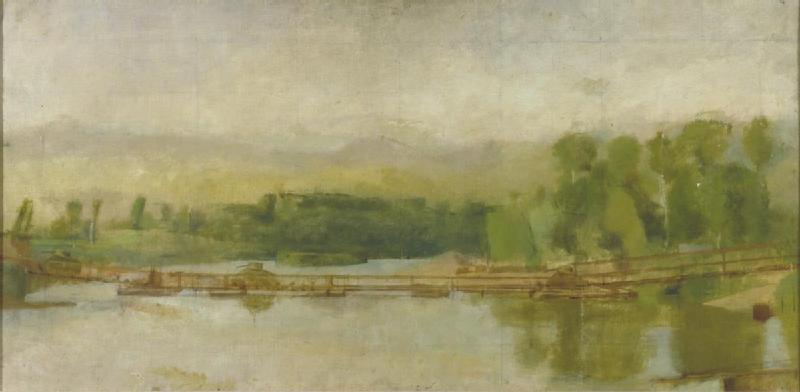The East London Group of Artists was a group of artists who worked and showed together from 1928 to 1936. They were mostly working class, realist painters whose formal education had often stopped at elementary school.

APPLEDORE JOHN COOPER
John Cooper, who taught at Bethnal Green, eventually severed his connection with it after a disagreement. From the 1924-25 session he began teaching at the Bow and Bromley  Evening Institute in Coborn Road, E3. To this he eventually attracted key members of the Bethnal Green Art Club, such as Walter Steggles, Harold Steggles and Elwin Hawthorne,whom he asked to join him at Bow in 1927.
Evening Institute in Coborn Road, E3. To this he eventually attracted key members of the Bethnal Green Art Club, such as Walter Steggles, Harold Steggles and Elwin Hawthorne,whom he asked to join him at Bow in 1927.
 Evening Institute in Coborn Road, E3. To this he eventually attracted key members of the Bethnal Green Art Club, such as Walter Steggles, Harold Steggles and Elwin Hawthorne,whom he asked to join him at Bow in 1927.
Evening Institute in Coborn Road, E3. To this he eventually attracted key members of the Bethnal Green Art Club, such as Walter Steggles, Harold Steggles and Elwin Hawthorne,whom he asked to join him at Bow in 1927.
The charismatic Cooper had served in the Royal Flying Corps during the First World War and then attended the Slade School of Fine Art. Newly graduated, he was a professional painter of portraits and landscapes, supplementing his income by teaching evening classes. His advice was to paint what was around, straight from life, rather than painting images for greetings cards or copying posters of film stars or seed packets.
The Wharfe at Arthington Viaduct by John Cooper, mid- thirties
Walter Sickert also lectured to and mentored the students. His message was the same as Cooper’s: students did not need to go on expensive excursions to find landscapes to paint. ‘There is no need to go to Bognor,’ he said. ‘You can go into the Tube."

Some artists connected with the Slade occasionally provided teaching assistance and showed with the Group. These included Phyllis Bray (to become Cooper’s wife for a period), William Coldstream  and Charles George Hamilton Dicker
and Charles George Hamilton Dicker
 and Charles George Hamilton Dicker
and Charles George Hamilton Dicker
Early in 1933, American writer Helen McCloy in the “Boston Evening Transcript,” judged that “Never has there been so peculiarly English a group in modern art as these young workingmen” who had been able to convey “the very spirit of the Cockney, the happy robust soul who is England.” By end, in 1936, when the Group was holding its eighth annual show at Lefevre Galleries, the “Sunday Times” termed it “the most interesting and promising of our younger art societies.”

By then, John Cooper was middle-aged and had only a few years to live, dying in 1943. As a charismatic young painter from Yorkshire, he had inspired such raw material as errand boys, shopgirls, basket-makers and window cleaners to give up their precious spare time several days a week to attend his East End classes. After teaching in Bethnal Green, he moved to a school in Bow where he attracted several dozen students. Many of these painters, showing as the East London Art Club, had an exhibition at the Whitechapel Art Gallery in December 1928. This prompted Charles Aitken, its former director, then in charge of what is now Tate Britain, to display some of the pictures at the Millbank gallery early in 1929, and that show lead to the Lefevre Galleries series, provincial shows, participation in mixed exhibitions in Britain and abroad, plus solo shows for many of the members.
At the 1936 Venice Biennale, two East London Group members, Elwin Hawthorne and Walter Steggles, participated alongside luminaries such as Frank Brangwyn, Barbara Hepworth,
Barbara Hepworth, Gilbert Spencer and Philip Wilson Steer. Walter was one of the six surviving East London Group members that I traced, providing unique memories that otherwise would have died with him. When a small reunion was organized at Phyllis Bray’s house, Walter told her daughter Philippa - “John Cooper should have been decorated for what he did for artists.”
Gilbert Spencer and Philip Wilson Steer. Walter was one of the six surviving East London Group members that I traced, providing unique memories that otherwise would have died with him. When a small reunion was organized at Phyllis Bray’s house, Walter told her daughter Philippa - “John Cooper should have been decorated for what he did for artists.”
I think I have a painting by Cooper.
ReplyDelete